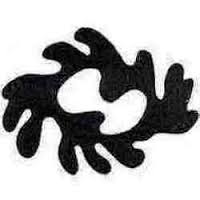Nov 06, 2015
Adinkra Cloth Symbols and Mathematics
Adinkra Cloth Symbols and Mathematics
The following is excerpted from “The Oxford Encyclopedia of African Thought edited by Edited by F. Abiola Irele and Biodun Jeyifo
Adinkra symbols also demonstrate forms of distinctive symmetry which, even though associated with conventional forms of symmetry, are neither drawn from nature nor related to mathematical forms. An example of this Binkabi [shown in the attached picture], which symbolizes the need for social unity.
Binkabi is closer to an amoebic form than to any other in nature but it cannot be considered definitely related to any physical or imaginative form. It suggests a form of topological transformation, topology being the mathematical field that studies spatial properties that remain invariant even when the shape of the form changes: that is, when it is rotated 180 degrees, its shape undergoes a variation of it previous appearance which still maintains its fundamental characteristics.
Within its amorphous structure, viewers can read any configuration that suits them. It could be an amoeba, a stylized buffalo, a rhino, or a rabbit. This simulation of imagination through an amorphous shape resonates in, and is amplified by, the empty space in its center, which can be seen as resembling the non-linear flow of the lines of a puddle, a cow’s coat markings, or any liquid shape. This visual plasticity ensures that the shape can be appreciated in terms of its traditional symbolism but also in relation to any other configuration the viewer wishes, This ideational flexibility is one of the strongest values of Adinkra realized in different ways in various adinkra symbols. The values of Adinkra as contemplative instrument, mathematical form, philosophical template, and historical lens, among others, have been addressed to some degree but need further development to realize their great interdisciplinary possibilities.


